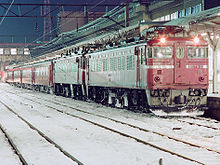JNR Class ED78
| Class ED78 | |||||||||||||||||||||||||||||
|---|---|---|---|---|---|---|---|---|---|---|---|---|---|---|---|---|---|---|---|---|---|---|---|---|---|---|---|---|---|
 ED78 9 in service in March 1985 | |||||||||||||||||||||||||||||
| |||||||||||||||||||||||||||||
| |||||||||||||||||||||||||||||
| |||||||||||||||||||||||||||||
| |||||||||||||||||||||||||||||
The Class ED78 (ED78形) was a Bo-2-Bo wheel arrangement AC electric locomotive type operated in Japan from 1968 until the 1990s.[1] 14 locomotives were built by Hitachi between 1967 and 1980.[2]
Operations
[edit]
The locomotives were introduced to operate on the steeply-graded Ou Main Line between Fukushima and Yonezawa, which was converted from 1,500 V DC electrification to 20 kV AC in October 1968.[1] The locomotives often worked in multiple with Class EF71 locomotives.[1]
History
[edit]A prototype locomotive, initially classified ED94 and numbered ED94 1, was delivered in 1967, with full-production locomotives delivered from 1968 until 1980.[1] ED94 1 was modified and renumbered ED78 901 in 1968.[3] All 14 locomotives were built by Hitachi in Mito, Ibaraki, with modifications to convert ED94 1 to ED78 901 carried out at JNR's Koriyama factory.[1]
Following the conversion of the Ou Main Line to standard gauge as part of the Yamagata Shinkansen in 1992, the Class ED78s were transferred to duties on the Tohoku Main Line and Senzan Line before ultimately being withdrawn.[1]
Build history
[edit]The individual build dates of the fleet were as follows.[1]
| Number | Build year | Remarks |
|---|---|---|
| ED78 901 | 1967 | Originally built as ED94 1 |
| ED78 1 | 1968 | |
| ED78 2 | 1968 | |
| ED78 3 | 1968 | |
| ED78 4 | 1968 | |
| ED78 5 | 1968 | |
| ED78 6 | 1968 | |
| ED78 7 | 1968 | |
| ED78 8 | 1968 | |
| ED78 9 | 1968 | |
| ED78 10 | 1970 | |
| ED78 11 | 1970 | |
| ED78 12 | 1980 | |
| ED78 13 | 1980 |
Preserved examples
[edit]As of 2015[update], one member of the class is preserved: ED78 1.[3] This locomotive was withdrawn in February 1987, and was subsequently stored at Fukushima Depot before being preserved at Fukushima Station.[4] It was then moved to a site adjoining Rifu Station in Miyagi Prefecture, and later moved to the nearby Sendai General Shinkansen Depot.[4] It was moved to Hitachi's Mito factory in Hitachinaka, Ibaraki in 2015 and cosmetically restored in 2016.[4]
-
ED78 1 preserved near Rifu Station in August 2002
-
ED78 1 preserved at Sendai General Depot in July 2008
-
ED78 1 preserved inside the Hitachi Mito factory in May 2017
Classification
[edit]The ED78 classification for this locomotive type is explained below.
- E: Electric locomotive
- D: Four driving axles
- 7x: AC locomotive with maximum speed exceeding 85 km/h (55 mph)
References
[edit]- ^ a b c d e f g Inoue, Koichi (1999). 国鉄機関車事典: 蒸気・電気・ディーゼル機関車66形式 国鉄機関車辞典 [JNR Locomotive Encyclopedia] (in Japanese). Japan: Sankaido. p. 152–153. ISBN 978-4-381-10338-3.
- ^ JR全車輛ハンドブック'92 [JR Rolling Stock Handbook 1992] (in Japanese). Japan: Neko Publishing. 1992. p. 41.
- ^ a b Sasada, Masahiro (25 November 2014). 国鉄&jr 保存車大全 2015-2016 国鉄&JR保存車大全2015-2016 [JNR & JR Preserved Rolling Stock Complete Guide 2015-2016] (in Japanese). Tokyo, Japan: Ikaros Publications Ltd. p. 25, 122. ISBN 978-4863209282.
- ^ a b c 修復を終えたED78 1が『さつきまつり』で展示される [ED78 1 displayed at Satsuki Festival following restoration]. Japan Railfan Magazine Online (in Japanese). Japan: Koyusha Co., Ltd. 6 June 2016. Retrieved 7 June 2016.




